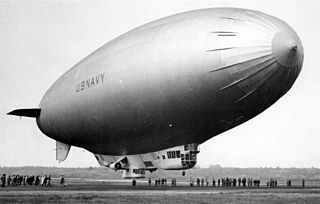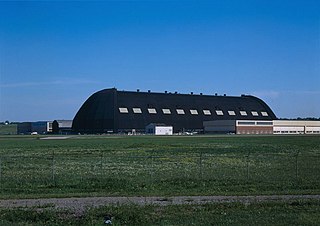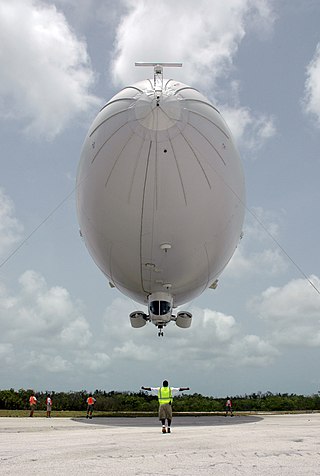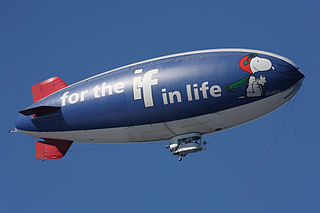Related Research Articles

A blimp, or non-rigid airship, is an airship (dirigible) without an internal structural framework or a keel. Unlike semi-rigid and rigid airships, blimps rely on the pressure of the lifting gas inside the envelope and the strength of the envelope itself to maintain their shape.

An airship or dirigible balloon is a type of aerostat or lighter-than-air aircraft that can navigate through the air under its own power. Aerostats gain their lift from a lifting gas that is less dense than the surrounding air.

The Zeppelin NT is a class of helium-filled airships being manufactured since the 1990s by the German company Zeppelin Luftschifftechnik GmbH (ZLT) in Friedrichshafen. The initial model is the N07. The company considers itself the successor of the companies founded by Ferdinand von Zeppelin which constructed and operated the very successful Zeppelin airships in the first third of the 20th century. There are, however, a number of notable differences between the Zeppelin NT and original Zeppelins as well as between the Zeppelin NT and usual non-rigid airships known as blimps. The Zeppelin NT is classified as a semi-rigid airship.

The Goodyear Blimp is any one of a fleet of airships operated by the Goodyear Tire and Rubber Company, used mainly for advertising purposes and capturing aerial views of live sporting events for television. The term blimp itself is defined as a non-rigid airship—without any internal structure, the pressure of lifting gas within the airship envelope maintains the vessel's shape.

The K-class blimp was a class of blimps built by the Goodyear Aircraft Company of Akron, Ohio for the United States Navy. These blimps were powered by two Pratt & Whitney Wasp nine-cylinder radial air-cooled engines, each mounted on twin-strut outriggers, one per side of the control car that hung under the envelope. Before and during World War II, 134 K-class blimps were built and configured for patrol and anti-submarine warfare operations, and were extensively used in the Navy’s anti-submarine efforts in the Atlantic and Pacific Ocean areas.

The G-Class Blimps were a series of non-rigid airships (blimps) used by the United States Navy. In 1935, instead of developing a new design airship, the Navy purchased the Goodyear Blimp Defender for use as a trainer and utility airship assigning it the designator G-1. Defender was built by the Goodyear Aircraft Company of Akron, Ohio and was the largest blimp in the company’s fleet of airships that were used for advertising and as passenger airships. Goodyear built additional G-class airships for the Navy during World War II to support training needs.

The L-class blimps were training airships operated by the United States Navy during World War II. In the mid-1930s, the Goodyear Aircraft Company built a family of small non-rigid airships that the company used for advertising the Goodyear name. In 1937 the United States Navy awarded a contract for two different airships, K-class blimp designated K-2 and a smaller blimp based upon Goodyear's smaller commercial model airship used for advertising and passenger carrying. The smaller blimp was designated by the Navy as L-1. It was delivered in April 1938 and operated from the Navy's lighter-than-air facility at Lakehurst, New Jersey. In the meantime, the Navy ordered two more L-Class blimps, the L-2 and L-3, on September 25, 1940. These were delivered in 1941. L-2 was lost in a nighttime mid-air collision with the G-1 on June 8, 1942.

The J-class blimps were non-rigid airships designed by the Navy Bureau of Aeronautics and Goodyear Tire & Rubber Company in the early 1920s for the US Navy.

The Goodyear Aircraft Company of Akron, Ohio built the M-class blimp for the US Navy as the follow-on to the K-class anti-submarine warfare blimp used during World War II. It was a significantly larger airship, 50% larger than its predecessor. Four airships, designated M-1 through M-4, were delivered in early 1944. Operations of K-ships in tropical regions had shown a need for a blimp with greater volume to offset the loss of lift due to high ambient temperatures.

The N-Class, or as popularly known, the "Nan ship", was a line of non-rigid airships built by the Goodyear Aircraft Company of Akron, Ohio for the US Navy. This line of airships was developed through many versions and assigned various designators as the airship designation system changed in the post World War II era. These versions included airships configured for both anti-submarine warfare and airborne early warning (AEW) missions.

Goodyear Aerospace Corporation (GAC) was the aerospace and defense subsidiary of the Goodyear Tire and Rubber Company. The company was originally operated as a division within Goodyear as the Goodyear Zeppelin Corporation, part of a joint project with Luftschiffbau Zeppelin, leading to the development of rigid airships in the United States. As part of the failing relationship between the US and Germany in the era prior to World War II, the division was spun off as Goodyear Aircraft Company in 1939. The company opened a new factory in Arizona in 1941 which produced subassemblies, including subcontracted airframe construction and the design of the Goodyear F2G Corsair and Goodyear Duck.

The Goodyear Airdock is a construction and storage airship hangar in Akron, Ohio. At its completion in 1929, it was the largest building in the world without interior supports.

The Airship Industries Skyship 600 is a modern airship, originally designed by British company Airship Industries, further developed by a subsidiary of Westinghouse Electric Corporation the type certificate holder is now Skyship Services of Orlando, Florida in the United States.

The B class blimps were patrol airships operated by the United States Navy during and shortly after World War I. The Navy had learned a great deal from the DN-1 fiasco. The result was the very successful B-type airships. Dr. Jerome Hunsaker was asked to develop a theory of airship design, Lt. John H. Towers had returned from Europe having inspected British designs, and using reports from attachés on British airship operations, the Navy was prepared to seek bids for blimps from American manufacturers. On 4 February 1917 the Secretary of the Navy directed that 16 nonrigid airships of Class B be procured. A February 12, 1917 meeting with the Chief of the Bureau of Construction and Repair, and representatives of Goodyear, Goodrich, Connecticut Aircraft Company, Curtiss Aeroplane and Motor Corporation, and U.S. Rubber Company, it was agreed that the order for 16 dirigibles was beyond the capability of any one company. The conference resulted in a committee to coordinate on sharing raw materials, information and experience. Ultimately Goodyear manufactured 9 envelopes, Goodrich made 5 and Curtiss assembled the gondolas for all of those 14 ships. Connecticut Aircraft contracted with U.S. Rubber for its two envelopes and with Pigeon Fraser for its gondolas. The Curtiss-built gondolas used by Goodyear and Goodrich used modified Curtiss JN-4 fuselages powered by Curtiss OXX engines. The Connecticut Aircraft blimps were powered by Hall-Scott engines. One ship, B-20 was equipped with a special control car. All B-Class airships were delivered to the Navy between August 1917 (B-1) and September 1918 (B-20).
The K-1 was an experimental blimp designed by the United States Navy in 1929. Due to the inability to get Congressional approval for the construction of an airship the navy used the ploy of ordering a "universal" control car which could be used on the J-type airships from the Naval Aircraft Factory. An order was placed with Goodyear Tire and Rubber Company for an envelope to hold "experimental gases". To complete the deception, there is no record of the US Navy assigning a serial number to the K-1, Standard Army TC type tail fins were procured from Goodyear. Unlike past Navy blimps, the control car was not suspended from external cables, but was hung from cables attached to the top of the envelope, and the car was carried flush against the envelope as in modern blimps. The control car carried bunks and a galley so that a relief crew could be carried, and was completely enclosed. The K-1 was also the first Navy blimp to have a taxi wheel. Like the Graf Zeppelin, the fuel for the K-1 was "blau gas" a mixture of combustible gases with the same density as air, which meant that the valving of gas as the fuel was consumed was not necessary. The only serious drawback was the tendency of the fuel to leak into the helium which then could not be run through the Lakehurst purification plant, which meant the expensive helium had to be vented to atmosphere when too contaminated or an overhaul was necessary.
The Goodyear Type AD was a small airship built in the United States in the mid-1920s. The first example, christened Pilgrim, was Goodyear's first civil airship, and their first airship to use helium as its lift gas. Originally intended for pleasure cruising, it soon found its true calling as a promotional vehicle as the first "Goodyear Blimp" in a line that has continued for over ninety years. The Type AD was a conventional blimp design with a gondola that could carry two passengers in addition to the flight crew. While usually described as a non-rigid type, the design in fact incorporated a triangular-section magnesium girder as a keel, fastened inside the envelope. The craft carried its own collapsible mooring mast which allowed it to "land" anywhere that 250 ft × 250 ft of clear ground was available.

The Goodyear GZ-20/20A was a class of non-rigid airship or blimp introduced in 1969 by The Goodyear Tire and Rubber Company in the United States as its signature promotional aircraft, the Goodyear Blimp. The design is based on the previous Goodyear GZ-19 class. The GZ-20 featured a larger envelope to carry the "Super-Skytacular" advertising night sign and more powerful engines. The GZ-20s were the mainstay of Goodyear's airship operations until 2017, when they were replaced with the new Zeppelin NT semi-rigid airship.

Airship Industries was a British manufacturers of modern non-rigid airships (blimps) active under that name from 1980 to 1990 and controlled for part of that time by Alan Bond. The first company, Aerospace Developments, was founded in 1970, and a successor, Hybrid Air Vehicles, remains active as of 2022. Airship Industries itself was active between 1980 and 1990.

American Blimp Corporation (ABC) is an American privately owned Hillsboro, Oregon-based company that is the largest manufacturer of blimps in the United States. It manufactures the hardware and rigging for the Lightship and Spector brands of airships. In 2012, American Blimp Corporation and The Lightship Group were acquired by Van Wagner Communications LLC, and became referred to as the Van Wagner Airship Group. On November 17, 2017, the Florida-based AirSign Inc. purchased the American Blimp Corporation and the Van Wagner Airship Group. In additional to getting 15 airships in the acquisition, AirSign also purchased the A-170 airship (MZ-3A) from the U.S. Navy. With ownership and management of Van Wagner's global airship operations, including staff with decades of experience in the airship industry, AirSign became as the world's largest airship company.
References
Notes
- 1 2 3 4 Taylor 1996, p. 548
- ↑ "Blimp Arbourne". Air Progress. December 1987.
- ↑ "Type Certificate Data Sheet No.AS1GL Lockheed Martin (Loral) GZ-22" (PDF). Federal Aviation Authority. 1 October 1997. Retrieved 2009-07-27.
- ↑ "Aircraft: Loral Corp. GZ-22, registration: N4A". National Transportation Safety Board. 17 May 2001. Retrieved 2009-07-27.
- ↑ Elliott, Dave (10 January 2018). "LORAL GZ-22 "SPIRIT OF AKRON"". MAPS Air Museum. Retrieved 9 December 2018.
Bibliography
- Taylor, Michael J. H. (1996). Brassey's World Aircraft & Systems Directory . London, England: Brassey's. ISBN 1-85753-198-1.